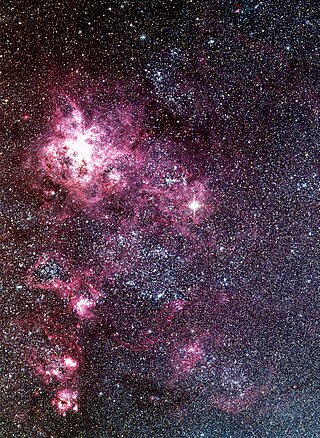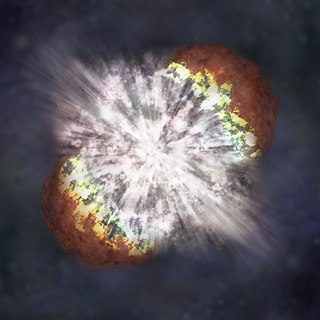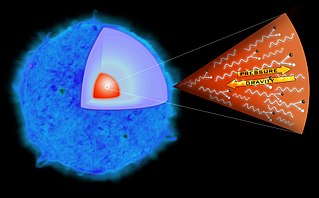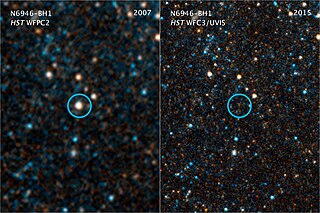The Chandrasekhar limit is the maximum mass of a stable white dwarf star. The currently accepted value of the Chandrasekhar limit is about 1.4 M☉ (2.765×1030 kg). The limit was named after Subrahmanyan Chandrasekhar.

A supernova is a powerful and luminous explosion of a star. A supernova occurs during the last evolutionary stages of a massive star, or when a white dwarf is triggered into runaway nuclear fusion. The original object, called the progenitor, either collapses to a neutron star or black hole, or is completely destroyed to form a diffuse nebula. The peak optical luminosity of a supernova can be comparable to that of an entire galaxy before fading over several weeks or months.

Stellar evolution is the process by which a star changes over the course of time. Depending on the mass of the star, its lifetime can range from a few million years for the most massive to trillions of years for the least massive, which is considerably longer than the current age of the universe. The table shows the lifetimes of stars as a function of their masses. All stars are formed from collapsing clouds of gas and dust, often called nebulae or molecular clouds. Over the course of millions of years, these protostars settle down into a state of equilibrium, becoming what is known as a main-sequence star.

SN 1987A was a type II supernova in the Large Magellanic Cloud, a dwarf satellite galaxy of the Milky Way. It occurred approximately 51.4 kiloparsecs from Earth and was the closest observed supernova since Kepler's Supernova in 1604. Light and neutrinos from the explosion reached Earth on February 23, 1987 and was designated "SN 1987A" as the first supernova discovered that year. Its brightness peaked in May of that year, with an apparent magnitude of about 3.

Supergiants are among the most massive and most luminous stars. Supergiant stars occupy the top region of the Hertzsprung–Russell diagram with absolute visual magnitudes between about −3 and −8. The temperature range of supergiant stars spans from about 3,400 K to over 20,000 K.
A Thorne–Żytkow object, also known as a hybrid star, is a conjectured type of star wherein a red giant or red supergiant contains a neutron star at its core, formed from the collision of the giant with the neutron star. Such objects were hypothesized by Kip Thorne and Anna Żytkow in 1977. In 2014, it was discovered that the star HV 2112, located in the Small Magellanic Cloud (SMC), was a strong candidate. Another possible candidate is the star HV 11417, also located in the SMC.
The Eddington luminosity, also referred to as the Eddington limit, is the maximum luminosity a body can achieve when there is balance between the force of radiation acting outward and the gravitational force acting inward. The state of balance is called hydrostatic equilibrium. When a star exceeds the Eddington luminosity, it will initiate a very intense radiation-driven stellar wind from its outer layers. Since most massive stars have luminosities far below the Eddington luminosity, their winds are mostly driven by the less intense line absorption. The Eddington limit is invoked to explain the observed luminosity of accreting black holes such as quasars.

A super-luminous supernova is a type of stellar explosion with a luminosity 10 or more times higher than that of standard supernovae. Like supernovae, SLSNe seem to be produced by several mechanisms, which is readily revealed by their light-curves and spectra. There are multiple models for what conditions may produce an SLSN, including core collapse in particularly massive stars, millisecond magnetars, interaction with circumstellar material, or pair-instability supernovae.

A blue supergiant (BSG) is a hot, luminous star, often referred to as an OB supergiant. They are usually considered to be those with luminosity class I and spectral class B9 or earlier, although sometimes A-class supergiants are also deemed blue supergiants.

An intermediate-mass black hole (IMBH) is a class of black hole with mass in the range 102–105 solar masses: significantly higher than stellar black holes but lower than the 105–109 solar mass supermassive black holes. Several IMBH candidate objects have been discovered in the Milky Way galaxy and others nearby, based on indirect gas cloud velocity and accretion disk spectra observations of various evidentiary strength.

A stellar black hole is a black hole formed by the gravitational collapse of a star. They have masses ranging from about 5 to several tens of solar masses. They are the remnants of supernova explosions, which may be observed as a type of gamma ray burst. These black holes are also referred to as collapsars.

NGC 6946, sometimes referred to as the Fireworks Galaxy, is a face-on intermediate spiral galaxy with a small bright nucleus, whose location in the sky straddles the boundary between the northern constellations of Cepheus and Cygnus. Its distance from Earth is about 25.2 million light-years or 7.72 megaparsecs, similar to the distance of M101 in the constellation Ursa Major. Both were once considered to be part of the Local Group, but are now known to be among the dozen bright spiral galaxies near the Milky Way but beyond the confines of the Local Group. NGC 6946 lies within the Virgo Supercluster.

Luminous blue variables (LBVs) are massive evolved stars that show unpredictable and sometimes dramatic variations in their spectra and brightness. They are also known as S Doradus variables after S Doradus, one of the brightest stars of the Large Magellanic Cloud. They are considered to be rare.

NGC 7793 is a flocculent spiral galaxy in the southern constellation of Sculptor. It was discovered in 1826 by Scottish astronomer James Dunlop. The galaxy is located at a distance of 12.2 million light years and is receding with a heliocentric radial velocity of 227 km/s. NGC 7793 is one of the five brightest galaxies within the Sculptor Group.

A pair-instability supernova is a type of supernova predicted to occur when pair production, the production of free electrons and positrons in the collision between atomic nuclei and energetic gamma rays, temporarily reduces the internal radiation pressure supporting a supermassive star's core against gravitational collapse. This pressure drop leads to a partial collapse, which in turn causes greatly accelerated burning in a runaway thermonuclear explosion, resulting in the star being blown completely apart without leaving a stellar remnant behind.

Gamma-ray burst progenitors are the types of celestial objects that can emit gamma-ray bursts (GRBs). GRBs show an extraordinary degree of diversity. They can last anywhere from a fraction of a second to many minutes. Bursts could have a single profile or oscillate wildly up and down in intensity, and their spectra are highly variable unlike other objects in space. The near complete lack of observational constraint led to a profusion of theories, including evaporating black holes, magnetic flares on white dwarfs, accretion of matter onto neutron stars, antimatter accretion, supernovae, hypernovae, and rapid extraction of rotational energy from supermassive black holes, among others.

A quasi-star is a hypothetical type of extremely massive and luminous star that may have existed early in the history of the Universe. They are thought to live around 7-10 million years. Unlike modern stars, which are powered by nuclear fusion in their cores, a quasi-star's energy would come from material falling into a black hole at its core. Quasars emit massive amounts of energy across the electromagnetic spectrum, from radio waves to gamma rays. They were first proposed in the 1960s and have since provided valuable insights into the early universe, galaxy formation, and the behavior of black holes. Although they have not been observed, they are considered to be the largest possible stars in the universe.

N6946-BH1 is a disappearing supergiant star and failed supernova candidate formerly seen in the galaxy NGC 6946, on the northern border of the constellation of Cygnus. The star, either a red supergiant or a yellow hypergiant, was 25 times the mass of the Sun, and was 20 million light years distant from Earth. In March through to May 2009 its bolometric luminosity increased to at least a million solar luminosities, but by 2015 it had disappeared from optical view. In the mid and near infrared an object is still visible, however, it is fading away with a brightness proportional to t−4/3. The brightening was insufficient to be a supernova; the process that created the outburst is still uncertain.

A hypernova is a very energetic supernova which is believed to result from an extreme core-collapse scenario. In this case, a massive star collapses to form a rotating black hole emitting twin astrophysical jets and surrounded by an accretion disk. It is a type of stellar explosion that ejects material with an unusually high kinetic energy, an order of magnitude higher than most supernovae, with a luminosity at least 10 times greater. Hypernovae release such intense gamma rays that they often appear similar to a type Ic supernova, but with unusually broad spectral lines indicating an extremely high expansion velocity. Hypernovae are one of the mechanisms for producing long gamma ray bursts (GRBs), which range from 2 seconds to over a minute in duration. They have also been referred to as superluminous supernovae, though that classification also includes other types of extremely luminous stellar explosions that have different origins.
SN 2009ip was a supernova discovered in 2009 in the spiral galaxy NGC 7259 in the constellation of Piscis Austrinus. Since the brightness waned after days post-discovery, it was redesignated as Luminous blue variable (LBV) Supernova impostor.
















